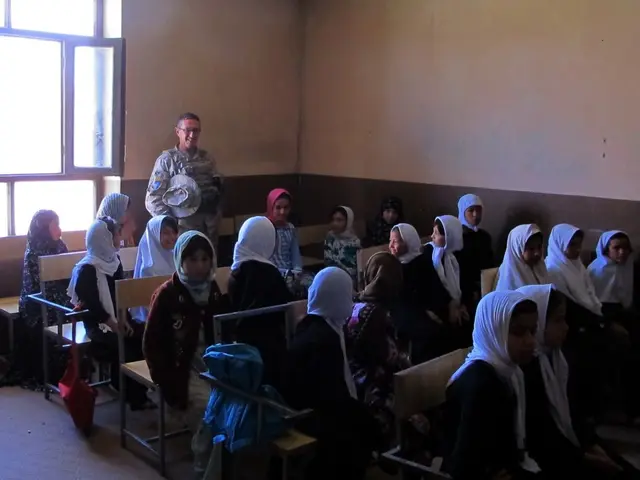Welfare encourages Ukrainians, as demonstrated in Europe's approach. - Does the funding of Ukrainian citizens corrupt their economy?
In the wake of the ongoing conflict in Ukraine, many refugees have sought safety and opportunities in European countries. While some nations have provided generous social support systems, others have offered better job opportunities and smoother integration processes, leading to significant differences in employment rates among Ukrainian refugees.
Refugees in Poland, the Czech Republic, and the Netherlands have enjoyed free access to education and healthcare systems, putting them on par with local families. This parity, however, is not the primary factor driving the higher employment rates in these countries compared to Germany.
Germany has taken in around 1.23 million refugees from Ukraine since February 2022, a substantial number. However, the employment rate for Ukrainian refugees in Germany remains lower than in countries like Poland, the Czech Republic, and the Netherlands. This disparity is primarily due to differences in job opportunities, language proficiency, diploma recognition, and integration dynamics rather than social assistance alone.
Research indicates that Ukrainian refugees prioritize labor market prospects over welfare benefits when choosing where to settle in Europe. Countries with more accessible or abundant job openings, especially in physically demanding or unskilled labor sectors, tend to have higher refugee employment rates.
Language skills and diploma recognition are critical barriers for many Ukrainian refugees. Despite holding higher education degrees, many struggle to find jobs in their fields due to language difficulties and complex processes for validating foreign diplomas. This leads to a majority working in unskilled jobs, but the extent varies depending on how well integration policies address these issues.
Germany's relatively lower employment rate among Ukrainian refugees is linked to greater challenges in rapid integration into its labor market. While 39% of Ukrainians in Germany are employed with jobs matching their qualifications due to language skills, a significant portion remains unemployed or underemployed because of slower diploma recognition and language acquisition.
In contrast, Poland, the Czech Republic, and the Netherlands tend to offer more immediate labor market access in unskilled or manual jobs. These countries may have lower barriers to entry for unskilled roles, allowing refugees to find employment faster even if it does not match their qualifications. The sheer volume of Ukrainians in Poland and Czechia relative to the population also creates more diverse informal network opportunities facilitating employment.
Social support systems like the Citizen's Allowance are similar across these countries but play a minor role compared to actual job availability and integration policies. Welfare generosity has limited influence on the refugees' employment rates or country choice compared to labor market conditions.
In Italy, Ukrainians have access to healthcare, the labor market, education, training, and internships. However, since April 2025, no financial support has been paid out, only material aid in the form of accommodation. Those without accommodation upon arrival can receive financial support for up to three months until April 2025.
In Bulgaria, around 60,800 people from Ukraine currently live, making it a more of a transit country. Ukrainians can receive a one-time support of up to 806 euros under certain conditions. In Bulgaria, around 100,000 people from Ukraine have stayed, but employment data is not readily available.
In the Netherlands, approximately 124,000 Ukrainian refugees live, mostly in state-funded accommodations. Each Ukrainian receives a contribution towards living expenses called "leefgeld". Ukrainians' entitlement to "leefgeld" ends when they start paid work.
The Czech Republic has taken in the most Ukrainian refugees compared to its population of just under eleven million, among all EU countries. The Ministry of the Interior in the Czech Republic counts 581,184 Ukrainians. The monthly Citizen's Allowance rate for singles is 563 euros, plus accommodation and heating.
In Romania, around 100,000 Ukrainian refugees have stayed, with the employment office having registered 24,057 and placed 3,271 in jobs. The employment rate for Ukrainian refugees in Romania is not currently available.
In summary, higher employment rates in Poland, the Netherlands, and Czech Republic stem from better access to labor markets for unskilled work, fewer language and diploma recognition hurdles in initial employment, and stronger refugee network effects, rather than differences in social support systems such as the Citizen's Allowance. Germany’s more stringent integration process and labor market entry challenges explain the relatively lower employment rate despite similar welfare provisions.
- Contrary to Germany, the employment rates for Ukrainian refugees in Poland, the Czech Republic, and the Netherlands are higher, primarily due to more accessible labor markets for unskilled work, fewer language and diploma recognition barriers, and stronger refugee network effects.
- In several European countries like Italy, the Netherlands, and the Czech Republic, financial support systems such as the Citizen's Allowance play a minor role compared to actual job availability and integration policies in determining employment rates among Ukrainian refugees.
- Countries with abundant job openings in physically demanding or unskilled labor sectors, like Poland, the Czech Republic, and the Netherlands, tend to have higher employment rates for Ukrainian refugees, who often prioritize labor market prospects over welfare benefits when choosing where to settle in Europe.




